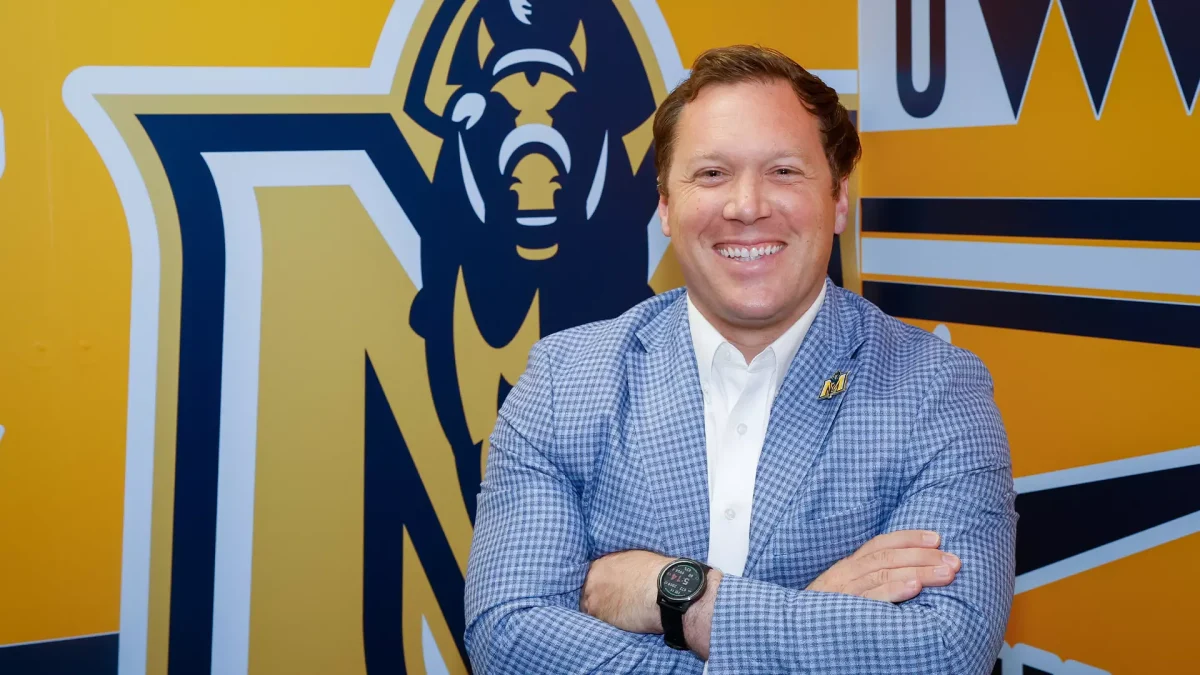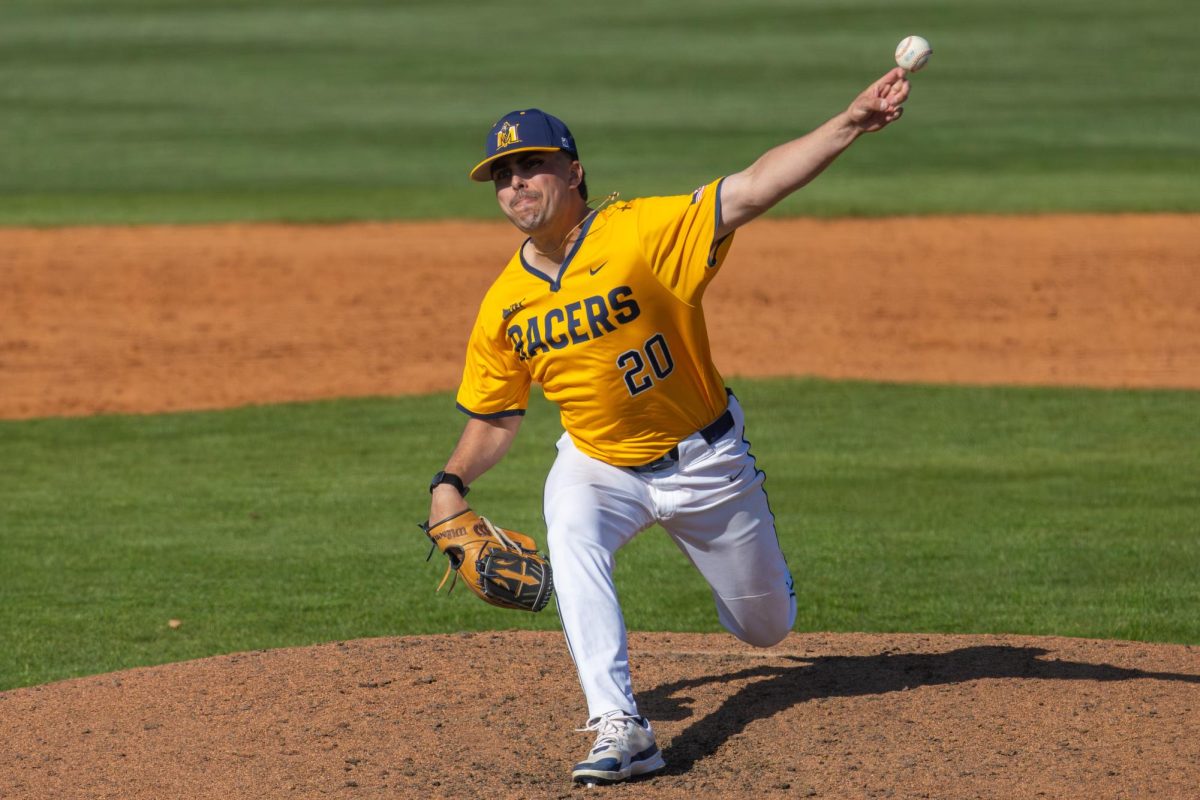Story by Abby Siegel, Contributing writer

Branden Higginson, sophomore from Mayfield, Kentucky, holds a sign expressing how racism makes him feel.
Lunch at the Thoroughbred Room on campus around noon provides an image of the student body at Murray State. Clusters of students gather, holding tiny slips of paper waiting for their numbers to be called and their hamburgers to be ready.
Others are crowding around a long table, already munching on their food, wearing similar shirts that represent the brotherhood they love. Students are working hard at Dunker’s Deli, toasting sandwiches and making salads for those looking for a light lunch.
This is the student body. They are tall, skinny, short and stubby. They are overachieving, procrastinating and busier than they’d anticipated. They are black; they are white; they are just about every hue in between. They are one body, but they are not treated the same.
The University includes students, faculty and staff from more than 60 countries and 43 states and the roughly 140 registered student organizations include missions to promote different religious, social, educational and ethnic issues.
“We want to make sure everyone on this campus feels valued, part of things, not like an outsider,” said Don Robertson, vice president of Student Affairs.
Robertson described the student population as open-minded, accepting and able to appreciate the differences of others. He said the community is stronger since the racist comments posted last fall on Yik Yak – an anonymous social media app. The comments sparked a student, faculty and staff-led event on the Carr Health Building’s lawn last October, titled Eracism, to address racism at the University.
Ariel Mitchell, junior from Louisville, Kentucky attended Eracism and said since then, she has intentionally pointed out microaggressions – or subtle racism – to some friends, who she said she was experiencing microaggressions from those people.
“What people need to understand is that racism isn’t being mean to someone because of their skin tone,” Mitchell said. “Microaggressions are socially taught, and when we say them we don’t know that they’re racist.”
The borders of the University campus do not confine the effects of racism that influence students.
Nikkous Crump, senior from Memphis, Tennessee, is an African-American student in the National Guard. He said he believes Murray State is inclusive, but the city and surrounding areas are not. He said he has felt tension at the Wal-Mart and the gas station in Benton, Kentucky, regarding his race when he is not in uniform.
Crump said he believes people aren’t necessarily racists. Instead, he said it is likely they fear being offensive or saying the wrong thing, as well as being uncomfortable with the social environment that they are not used to.
“It’s a problem,” he said. “But it goes beyond Murray State.”
Robertson said if students feel that citizens within the community have oppressed them, they should let faculty or staff know because it will be addressed with the appropriate city officials.
‘FEAR OF THE UNKNOWN’
Mary Tripp Reed, lecturer of economics, spoke at the Eracism event and said educating people on the issue allows them to do more than just react to the media.

Students protest outside of Waterfield Library last fall because of the shooting of Mike Brown in Ferguson, Missouri.
Reed said she encourages students to ask themselves, “At what point did you realize your class, race and gender,” and, “At what age did you realize that was part of your identity?” Reed said the answers to these questions often encourage students to take action or at least have a greater understanding of their role in the issue of identity.
“It isn’t either you’re racist or you’re not,” she said. “That’s just not accurate.”
Reed said the feelings of racism are rooted in fear of being embarrassed and lack of experience interacting with the ethnicity encountered.
“Let’s not be naive – there is some fear and hatred,” she said. “But it is mostly a fear of the unknown.”
Although the University has addressed issues regarding inequality and racism, collectively students and faculty said they believe the conversation isn’t over yet.
Nathan Brown, junior from Trenton, Illinois, grew up near east St. Louis where the Ferguson shootings took place and uses his experiences with part of the city to influence his opinions of those different than him.
On Aug. 9, 2014, Mike Brown, an unarmed black teenager, was shot and killed by Darren Wilson, a white police officer in Ferguson, Missouri. The shooting spurred rioters and protesters to flood the streets for several weeks afterward. A few months later in November, a grand jury decided not to indict Wilson, a decision that sparked another round of protests in the small town.
“I try not to let it affect how I view other people,” Nathan Brown said. “You can’t judge them and how they grew up because you are different to them, too.”
He said he encourages students to be aware of issues in society and to see things from all sides of the story, and that comes from being educated on the issue.
CONTINUING THE CONVERSATION
“For some reason, nobody is particularly comfortable talking about the topic of racism,” said Jasmine Young, graduate student from Louisville, Kentucky.
Subtle racism can include groups of the same race, sexual orientation or religious belief often sticking together.
“Black events are open to everyone but it is hard for other ethnicities to come because they don’t feel welcome,” said Victoria Yocum, junior from Bardstown, Kentucky.
Yocum said people are afraid of stereotypes and being judged, so they don’t even approach the issue or event, and to a degree this perpetuates stereotypes.
To combat this, Reed suggests beginning the conversation in places in which students feel trust with others.
“If you have trust then you can talk about more intense issues,” she said. “It takes someone who has initiative to do it, no matter what ethnic background.”
Robertson said students shouldn’t underestimate the power of their voices and the roles they can play in educating the public on racism.
“If the students stand up and say this is not going to happen on our campus, then that is the quickest way to stop it,” he said.
He said he believes students – and especially student leaders – play critical roles in combating racism by practicing bystander intervention when they know something is wrong with the way their peers are acting, no matter the behavior.
Bystander intervention is a prevention strategy that encourages individuals to interrupt situations that could lead to assaults and is often encouraged to prevent sexual assault and dating violence situations.
“Murray State is making strides of being an inclusive environment,” Yocum said. “However, there is always room for improvement.”




























































































